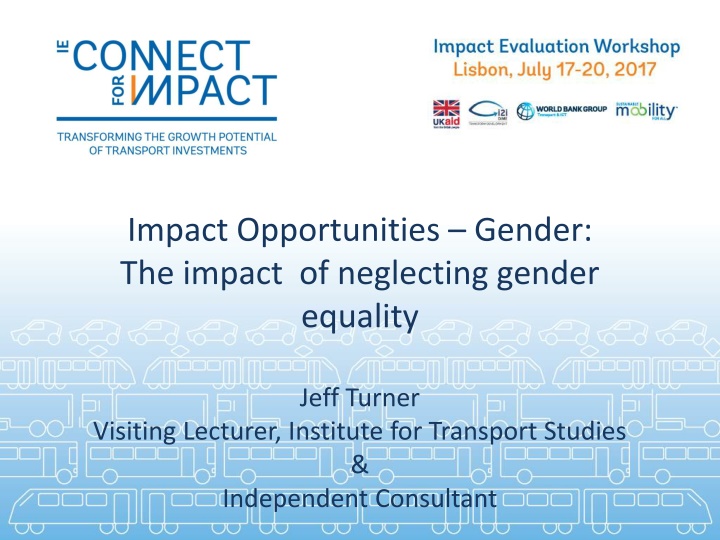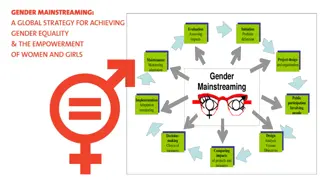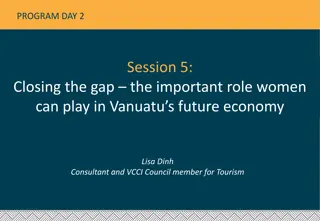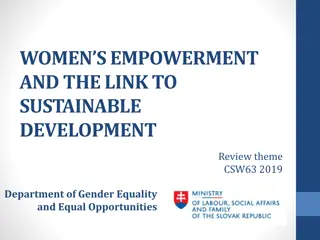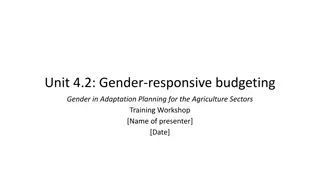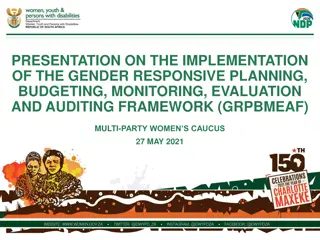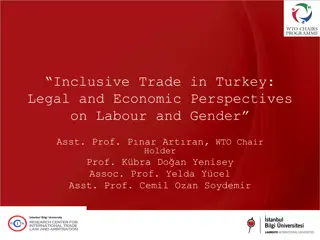Gender Equality in Transport: Impacts and Opportunities
Neglecting gender equality in transportation has wide-ranging consequences, as men and women differ in travel patterns, means of transport, purposes of travel, and feelings of safety. Gender disparities in economic response to transport costs, access to finance, labor market mobility, and urban accessibility contribute to significant economic costs. Understanding and implementing gender mainstreaming practices in transport projects are crucial for addressing these inequalities.
Download Presentation

Please find below an Image/Link to download the presentation.
The content on the website is provided AS IS for your information and personal use only. It may not be sold, licensed, or shared on other websites without obtaining consent from the author.If you encounter any issues during the download, it is possible that the publisher has removed the file from their server.
You are allowed to download the files provided on this website for personal or commercial use, subject to the condition that they are used lawfully. All files are the property of their respective owners.
The content on the website is provided AS IS for your information and personal use only. It may not be sold, licensed, or shared on other websites without obtaining consent from the author.
E N D
Presentation Transcript
Impact Opportunities Gender: The impact of neglecting gender equality Jeff Turner Visiting Lecturer, Institute for Transport Studies & Independent Consultant
Why Gender and Transport? It is clear from a significant body of research that, globally, as a result of gender differences in economic and societal roles, men and women differ in: The distances they travel The means by which they travel The purposes for which they travel The people and things they travel with and How safe and secure they feel when travelling
Gender differences in travel patterns In 2012 estimated that Informal Cross Border Trade contributes between 30-40 percent of total intra-SADC trade UN Women in 2008 estimated that 70 percent of people trading across borders in SADC are women accounting for 30 percent of goods by value. Men and trucks account for 30 percent of people and 70 percent of value
What are the economic costs of gender inequality in transport Gender differences in economic actor response to changes in transport costs (such as changes in productivity, employment, agglomeration, etc.) through gender differences in Skills, Access to finance Flexibility to respond to labour markets through spatial mobility Gender differences in transaction costs of urban survival as a result of gender differences in urban accessibility Economic costs of maternal health - research suggests that at least 25 percent of maternal mortality due to poor road access to emergency healthcare Economic cost of safety ADB study in 2004 across South Asia highlighted that half of poor households involved in fatal crashes were not poor prior to road crash
What can we learn from Gender mainstreaming practice in MDBs? The transport design and focus of the project will have biggest impact on gender equality and not necessarily the additional gender components . Gender inequality can not be completely mitigated through social safeguarding The priorities set and the focus of the resources invested within the project will determine the gender distribution of impacts Alas good gender equitable project design doesn t always translate in implementation Pre-determined project monitoring indicators will influence project implementation and hence gender impact What extent does/should the MDB rely on gender-equitable practice of client government to set priorities? Evidence base for gendered nature of areas such as ports, aviation and rail-freight is still limited
Presentations Arianna Legovini, DIME, World Bank Willing to Pay to Avoid Harassment (this is an impact evaluation of a women-only metro-car policy in Rio de Janeiro) Girija Borker, Brown University Safety First: Perceived Risk of Street Harassment and Educational Choices of Women Karla Dominguez Gonzalez, Transport & ICT, World Bank Bringing Gender into Transport and ICT: from Analysis to Operations (this will look into complementary road interventions that can enhance accessibility to women)
